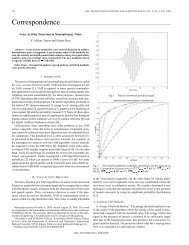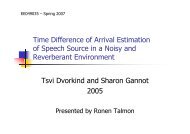Thesis (PDF) - Signal & Image Processing Lab
Thesis (PDF) - Signal & Image Processing Lab
Thesis (PDF) - Signal & Image Processing Lab
Create successful ePaper yourself
Turn your PDF publications into a flip-book with our unique Google optimized e-Paper software.
4.2. FILTERING USING MULTIPLE MINIMAL PATHS 53<br />
4.2 Filtering using multiple minimal paths<br />
An alternative way to avoid the trenches is to store, for each flat zone, all possible<br />
combinations of the path-variations, and to choose the most suitable one during<br />
filtering. The suitable path-variation is one that has a maximal common-part length.<br />
For the example given in Table 2.1, we can store, for the skeleton point x = 5, both<br />
BTV transform possibilities {−2, 13, −1} and {8, −3, 5}. Graphically, it can be seen<br />
in Fig. 4.6 that the vertex 5, (x = 5), has 2 possible origins - one from the vertex 4<br />
and another from vertex 6. For x = 4, the alternating sequence is {−2, 13}, thus its<br />
father is vertex 3. Therefore, the infimum path-variation of the two neighbors x = 4<br />
and x = 5 is either {0} or {−2, 13}, depending on which option we will choose. We<br />
choose the path-variation that has a maximal common part length - the option where<br />
vertex 4 is the father of vertex 5, that is, {−2, 13}. Of course, this process is more<br />
complex and more memory consuming.<br />
Another possible implementation is to store the information about multiple pos-<br />
sibilities for minimal paths, by enabling connections of the nodes to the multiple<br />
fathers in the TD-Tree. This saves the memory usage, but the price is computational<br />
overhead. In this case, the path-variation will be created a number of times for each<br />
pixel during the filtering, instead of to create it once for each flat zone - before the<br />
filtering. Our implementation uses the first option of storing multiple paths for each<br />
vertex.<br />
A drawback of this approach is that it does not fit all cases, but only those where<br />
the topographic distance is equal in the different paths. Obviously, it ignores a large<br />
number of cases, because the topographic distance does not have to be equal for<br />
multiple paths. Therefore, some trenches remain after the filtering. See the example<br />
given in Fig. 4.12.<br />
This method has another significant drawback - the performance issue. For real-<br />
world images, the number of combinations become very large, and the computation<br />
time and memory requirements are exponentially dependent on the number of flat<br />
zones in the image. Probably, it is possible, by using some heuristic methods, to<br />
reduce significantly the computation requirements, but this issue is out of the scope<br />
of this thesis.
















